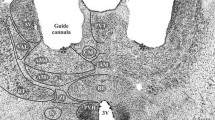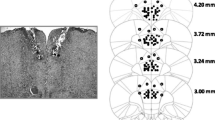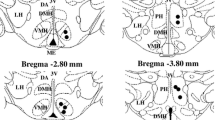Abstract
The tuberomammillary nucleus (TM), located in the posterior hypothalamic region, consists of five subgroups and is the only known source of brain histamine. In the present experiment, rats received bilateral ibotenic acid or sham lesions in the rostroventral part of the TM (E2-region). Three weeks later they were tested on the elevated plus-maze test of fear and anxiety. Lesions in the tuberomammillary E2-region elevated the time spent on the open arms, as well as excursions into the end of the open arms, increased scanning over the edge of an open arm, and decreased risk-assessment from an enclosed arm. Thus, partial destruction of TM intrinsic neurons can induce anxiolytic-like effects which are possibly related to a lesion-induced reduction of histaminergic activity.
Similar content being viewed by others
Author information
Authors and Affiliations
Additional information
Received: 28 August 1997 / Accepted: 20 November 1997
Rights and permissions
About this article
Cite this article
Frisch, C., Hasenöhrl, R., Krauth, J. et al. Anxiolytic-like behavior after lesion of the tuberomammillary nucleus E2-region. Exp Brain Res 119, 260–264 (1998). https://doi.org/10.1007/s002210050340
Issue Date:
DOI: https://doi.org/10.1007/s002210050340




